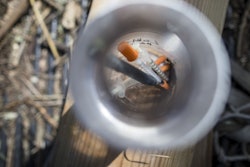KINGSPORT, Tenn. (AP) — "My TV's in the shop."
Have you heard anybody say that lately?
If so and you're in the Kingsport area, chances are that shop is the TV & Radio Clinic owned by Gary Darnell and this year marking its 50th anniversary. However, because of the scarcity of TV repair shops, the business draws repair work from Southwest Virginia, Southeastern Kentucky and Western North Carolina as well as the Tri-Cities.
Another television repair operation in the Tri-Cities is Taylor Television Inc., which has operated in Bristol, Va., since 1957.
In 2007, a Kingsport Times News article reported three television repair operations in the Kingsport area, but in 2017 Gary Darnell said his operation is the only one he knows about in Kingsport. A & G Electronics TV & VCR in the Fordtown Road area still has an operating phone and voicemail, but no one could be reached for comment there. A shop in the Colonial Heights section of town has closed.
Gary Darnell's father, Billy Darnell, opened the business in 1967 after buying out the stock of Radio and TV Repair owned by Ray Bays and started by Kelsey Klepper in the late 1940s or early 1950s. The elder Darnell, who worked for Bays after having worked for a Bloomingdale TV repair business, retired in 1999 and turned the business over to his son, who had worked in the business since 1979.
"Back then, there were five or six (TV repair shops) just in Kingsport," the younger Darnell said.
The elder Darnell, who worked for Bays starting in about 1964 and bought the business after Bays closed it. He opened the new business nearby, at 1101 E. Sevier Ave., in 1967. He still comes in three or four hours a day and does small projects, such as repairing VCRs and circuit boards.
"I'm just pretty much a one-man show beside Dad," Gary Darnell said recently at the shop one afternoon with his father.
The Darnells said the business draws customers from Harlan, Ky., as well as Norton, Big Stone Gap, St. Paul and Gate City in Virginia.
During an interview, he stopped to take a call from a woman in Spruce Pine, N.C., about bringing her TV to Darnell for repair. She told him, he said, that she can't find a repair place near her or in Asheville so she will be driving about an hour and a half to an hour and 45 minutes to Kingsport. The younger Darnell said she is making a day trip and he will try to get the repair done for her the same day, if possible.
In addition to televisions, the business works on VCRs and VCR/DVD combination units. The Darnells said although VCRs are not available new that folks still maintain them to watch their libraries of movies, TV shows and home videos still on VHS.
"I come down and work three or four hours a day with him," Billy Darnell said. "I do a lot of small stuff for him." That includes the VCRs and circuit board repair. "We've had three (VCRs) come in the last few days," the elder Darnell said. Despite the name, the business rarely works on radios. Most household ones are simply discarded when they cease to function, and the two said car radios require specialized codes not readily available to non-factory or non-dealer technicians.
TV repair shops used to stock common parts and could order parts for most any set, Gary Darnell said, adding that warranties on TVs that once cover picture tubes for two years and parts and labor on other repairs for one year have morphed into warranties that cover TVs for six months to a year. The new LCD TVs, which use LEDs to illuminate the picture, don't have a picture tube. Instead, they have an LCD-generated picture illuminated by the LEDs.
He said repairing the LED lighting is cost effective for larger sets, but repairing the LCDs is cost prohibitive. Sets with screens 32 inches and larger often are good candidates for repairs, depending on the brand and availability of parts, he said, but smaller sets and those with difficult-to-find parts are at best used to scavenge for parts. Most parts are ordered, the business rids its stock of old vacuum tubes and other older parts in the late 1980s or early 1990s.
"Parts back then were more standardized," the younger Darnell said.
"You can usually repair them (smaller sets) cheaper than you can replace them," he said. "There's some 32s I can repair a lot cheaper than you can buy one." His father, however, said a $99 32-inch set likely isn't worth fixing. Gary Darnell said that is particularly something folks should keep in mind when buying a TV on Black Friday. Many of those sets are manufactured specifically for the holiday sale and may not have the features or quality of more expensive sets, he said.
All this contrasts with the 1950s through 1990s, when the elder Darnell said folks generally would spend half the price of a new set to fix an old one.
"Most of the time we could fix 98 percent of the sets that came in here," said Billy Darnell, a graduate of the DeVry Technical Institute of Chicago. In his heyday, he said he would repair five or six sets a day, six days a week, and the average in the business was about four a day.






















